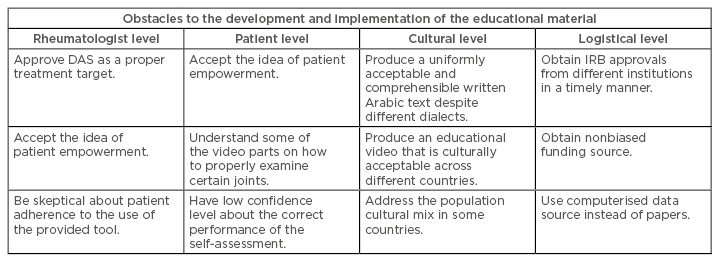BACKGROUND
The treat-to-target concept has revolutionised rheumatoid arthritis (RA) management and prognosis.1 Using a specific treatment target, such as Disease Activity Score (DAS)-28, and involving patients in their disease management can help to improve disease prognosis. The objective of this study was to develop and implement an educational video that instructs patients with RA how to carry out a self-assessment of disease activity using DAS-28.
METHODS
Step 1: Identify the Unmet Needs in Rheumatoid Arthritis Evaluation and Plan the Study
Rheumatologists from some Middle Eastern Arab countries (MEAC) were invited to participate in this study. The protocol draft was presented during regional meetings to identify the unmet needs in RA patients and to finalise the study protocol. International experts and societies were contacted to access pre-existing educational material.
Step 2: Adapt the Protocol and Produce the Educational Material
Different material sources2-5 were synthesised and translated into Arabic through a professional translation service, and specific medical terms were translated by the rheumatologists themselves. The Arabic text and English subtitles were validated by the rheumatologists through multiple email rounds. The simplified leaflet was developed in both Arabic and English languages. The educational video was shot by a professional team with a real patient and a rheumatologist on set. The voiceover was recorded with the presence of one of the medical team members in the studio.
Step 3: Validate the Educational Material
The final products (leaflet, text, subtitles, and video) were validated by the rheumatologists through email rounds. The material was tested on RA patients to assess comprehension and acceptability. Obstacles were noted at the various study levels.
RESULTS
A total of 23 rheumatologists from 7 MEAC participated in the study. A one-page educational leaflet was developed in both Arabic and English languages. An educational video presenting the treat-to-target concept and the basics of DAS performance in a simple way was produced with a voiceover in the Arabic language with English subtitles.6 Obstacles experienced at the rheumatologist, patient, cultural, and logistical levels were identified (Table 1) and the potential solutions were addressed by the study team. The solutions will be applied in the future steps of the Auto-DAS MEAC study.

Table 1: Obstacles faced during the conception and implementation of the educational tool for rheumatoid arthritis patient empowerment for self-assessment at the different levels: rheumatologist, patient, cultural, and logistical.
DAS: Disease Activity Score; IRB: Institutional Review Board.
CONCLUSIONS
Collaboration between several countries sharing the same language and similar cultural backgrounds and unmet needs was possible and allowed for the production of an educational material aimed at the empowerment of RA patients for the self-assessment of their disease activity. Obstacles to applying self-assessment were identified, and potential solutions will be applied to the future steps of the Auto-DAS MEAC study. The video will serve for future studies in Arabic-speaking countries and will be available for clinical use according to the rheumatologist’s clinical judgment.
Discussions with experts during the abstract display at the European League Against Rheumatism (EULAR) Congress in Amsterdam, Netherlands, yielded additional comments about the obstacles identified in Table 1, mainly surrounding the use of DAS as a proper treatment target. Several suggestions were made about the proper tool to adopt, which will be highly useful for the future steps of the study.








